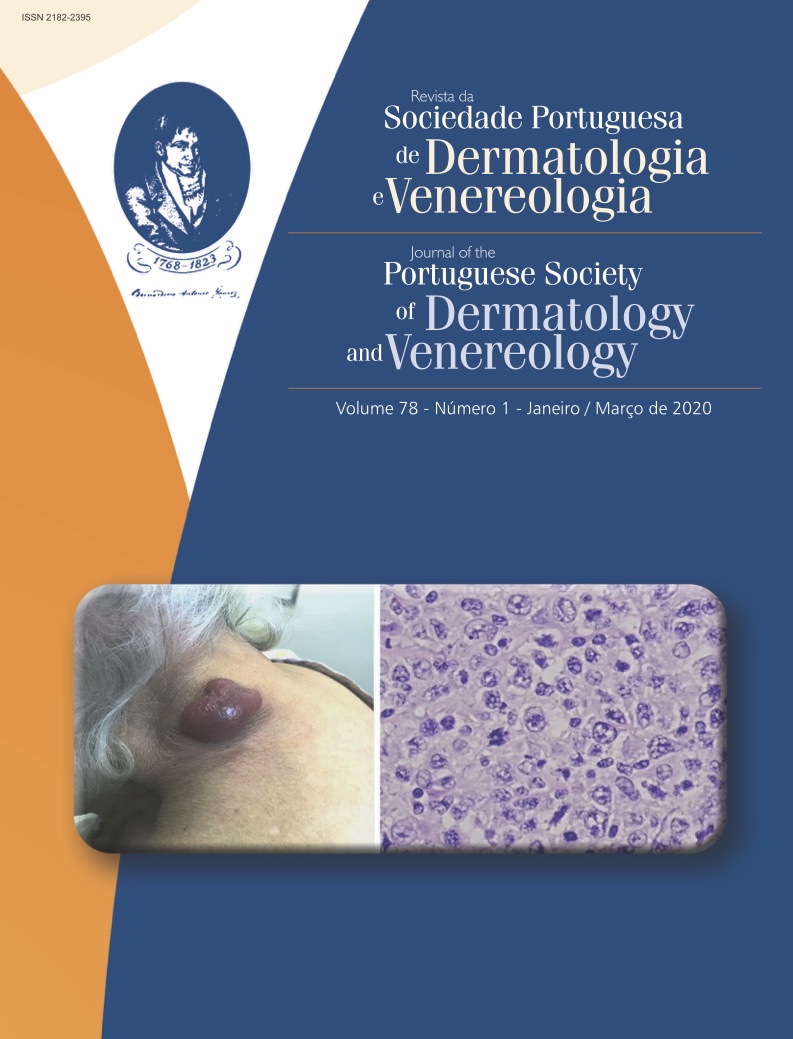Metástases Tardias de Melanoma Maligno Cutâneo Primário Fino
Resumo
O melanoma maligno cutâneo é o terceiro tipo mais comum de cancro de pele, e a sua incidência tem aumentado. A taxa de mortalidade associada é considerável, devido ao seu fenótipo agressivo e grande capacidade de metastização, principalmente nos primeiros anos de seguimento. As recidivas tardias, mais de 10 anos após o diagnóstico, são raras. O principal fator de prognóstico do melanoma maligno cutâneo é a espessura tumoral, que também determina o tipo de abordagem. Os tumores finos, geralmente, têm bom prognóstico. Reportamos o caso de uma mulher de 66 anos com antecedentes de excisão de um melanoma maligno cutâneo primário fino, localizado no dorso, que se apresentou 16 anos mais tarde com uma inesperada recidiva, rapidamente progressiva e letal.
Downloads
Referências
Whiteman DC, Green AC, Olsen CM. The Growing Burden of Invasive Melanoma: Projections of Incidence Rates and Numbers of New Cases in Six Susceptible Populations through 2031. J Invest Dermatol. 2016;136:1161-71. doi: 10.1016/j.jid.2016.01.035.
Vukomanovic P, Karanikolic A, Stefanoviic M, Mihajlovic D, Djordjevic B, Kutlesic R. Late recurrence of malignant melanoma mimicking ovarian malignancy. Eur J Gynaecol Oncol. 2010;31:590-2.
Mansour D, Kejariwal D. It is never too late: ultra-late recurrence of melanoma with distant metastases. BMJ Case Rep. 2012:bcr0120125474. doi: 10.1136/bcr.01.2012.5474.
Ruiz-Cuesta P, Hervás-Molina AJ, Villar-Pastor CM, Jurado-García J, Barrera-Baena P. Metastasis gastrica tardia de melanoma cutaneo. Gastroenterol Hepatol. 2014;37:564-5. doi: 10.1016/j.gastrohep.2014.01.009.
Osella-Abate S, Ribero S, Sanlorenzo M, Maule MM, Richiardi L, Merletti F, et al. Risk factors related to late metastases in 1,372 melanoma patients disease free more than 10 years. Int J Cancer. 2015;136:2453-7. doi: 10.1002/ijc.29281
Hansel G, Schönlebe J, Haroske G, Wollina U. Late recurrence (10 years or more) of malignant melanoma in south-east Germany (Saxony). A single-centre analysis of 1881 patients with a follow-up of 10 years or more. J Eur Acad Dermatol Venereol. 2010;24:833-6.
Damsky WE, Theodosakis N, Bosenberg M. Melanoma metastasis: new concepts and evolving paradigms. Oncogene. 2014;33:2413-22. doi: 10.1038/onc.2013.194.
Faries MB, Steen S, Ye X, Sim M, Morton DL. Late recurrence in melanoma: clinical implications of lost dormancy. J Am Coll Surg. 2013;217:27-34. doi: 10.1016/j.jamcollsurg.2013.03.007.
Swetter SM, Tsao H, Bichakjian CK, Curiel-Lewandrowski C, Elder DE, Gershenwald JE, et al. Guidelines of care for the management of primary cutaneous melanoma. J Am Acad Dermatol. 2019;80:208-50. doi: 10.1016/j.jaad.2018.08.055.
Garbe C, Amaral T, Peris K, Hauschild A, Arenberger P, Bastholt L, et al. European consensus-based interdisciplinary guideline for melanoma. Part 1: Diagnostics - Update 2019. Eur J Cancer. 2020;126:141–58. doi: 10.1016/j.ejca.2019.11.014.
Balch CM, Buzaid AC, Soong SJ, Atkins MB, Cascinelli N, Coit DG, et al. Final version of the American Joint Committee on Cancer staging system for cutaneous melanoma. J Clin Oncol. 2001;19:3635-48.
Brochez L, Verhaeghe E, Sales F, del Marmol V, Deraemaecker R, Vossaert K, et al. Current guidelines in melanoma treatment. Melanoma Working Group of Gent and Bordet. Dermatology. 2000;200:160-6.
Dunn CL, Zitelli JA. Standards of care for patients with malignant melanoma. J Am Acad Dermatol. 2000;43:155-8.
Kanzler MH, Mraz-Gernhard S. Primary cutaneous malignant melanoma and its precursor lesions: diagnostic and therapeutic overview. J Am Acad Dermatol. 2001;45:260-76.
Garbe C, Amaral T, Peris K, Hauschild A, Arenberger P, Bastholt L, et al. European consensus-based interdisciplinary guideline for melanoma. Part 2: Treatment - Update 2019. Eur J Cancer. 2020;126:159–77. doi: 10.1016/j.ejca.2019.11.015.
Kyrgidis A, Tzellos T, Mocellin S, Apalla Z, Lallas A, Pilati P, et al. Sentinel lymph node biopsy followed by lymph node dissection for localised primary cutaneous melanoma. Cochrane Database Syst Rev. 2015;5:CD010307. doi:10.1002/14651858.CD010307.pub2.
Stiegel E, Xiong D, Ya J, Funchain P, Isakov R, Gastman B, et al. Prognostic value of sentinel lymph node biopsy according to Breslow thickness for cutaneous melanoma. J Am Acad Dermatol. 2018;78:942-8. doi: 10.1016/j.jaad.2018.01.030.
Gimotty PA, Guerry D, Ming ME, Elenitsas R, Xu X, Czerniecki B, et al. Thin primary cutaneous malignant melanoma: a prognostic tree for 10-year metastasis is more accurate than American Joint Committee on Cancer staging. J Clin Oncol. 2004;22:3668-76.
Tsao H, Cosimi AB, Sober AJ. Ultra-late recurrence (15 years or longer) of cutaneous melanoma. Cancer. 1997;79:2361-70.
Pizzichetta MA, Talamini R, Stanganelli I, Puddu P, Bono R, Argenziano G, et al. Amelanotic/hypomelanotic melanoma: clinical and dermoscopic features. Br J Dermatol. 2004;150:1117-24.
Todos os artigos desta revista são de acesso aberto sob a licença internacional Creative Commons Attribution-NonCommercial 4.0 (CC BY-NC 4.0).








